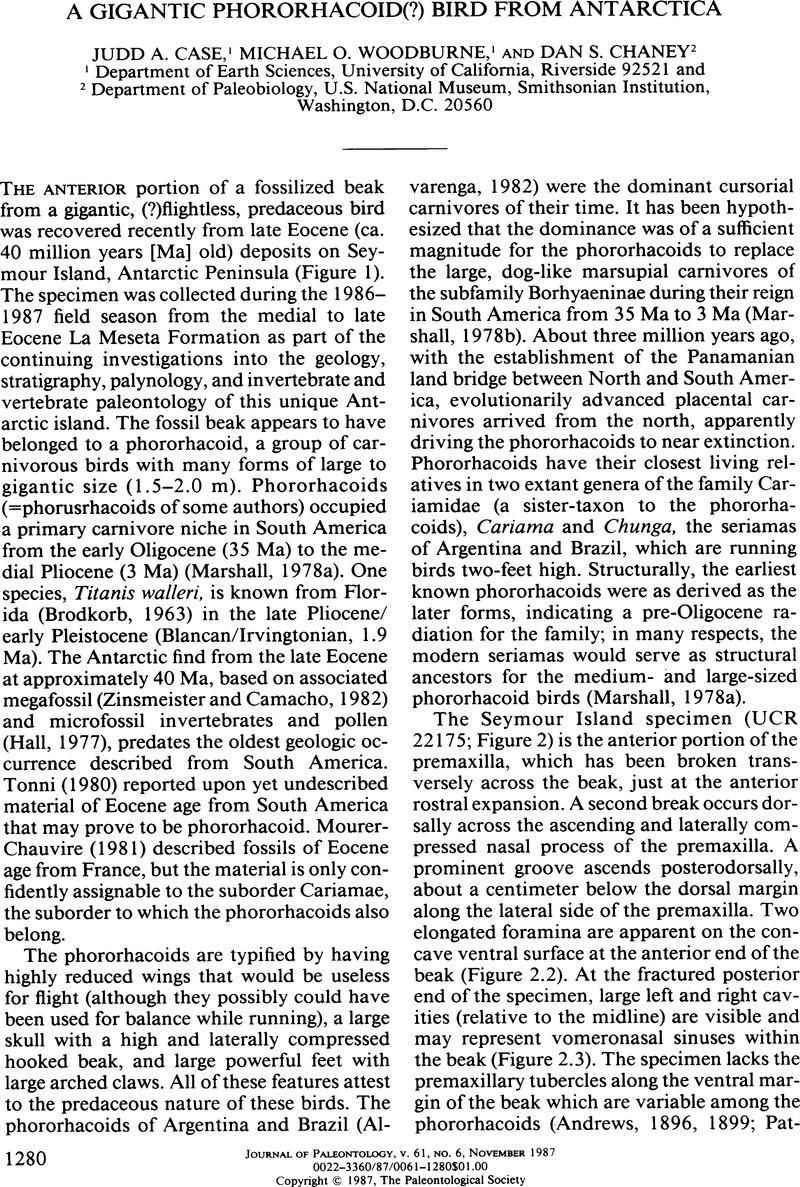Crossref Citations
This article has been cited by the following publications. This list is generated based on data provided by Crossref.
Askin, Rosemary A.
1989.
Endemism and heterochroneity in the Late Cretaceous (Campanian) to Paleocene palynofloras of Seymour Island, Antarctica: implications for origins, dispersal and palaeoclimates of southern floras.
Geological Society, London, Special Publications,
Vol. 47,
Issue. 1,
p.
107.
Molnar, R. E.
1989.
Terrestrial tetrapods in Cretaceous Antarctica.
Geological Society, London, Special Publications,
Vol. 47,
Issue. 1,
p.
131.
1992.
Molluscan Systematics and Biostratigraphy: Lower Tertiary La Meseta Formation, Seymour Island, Antartic Peninsula.
Vol. 55,
Issue. ,
Goin, Francisco J.
and
Carlini, Alfredo A.
1995.
An Early Tertiary Microbiotheriid Marsupial from Antarctica.
Journal of Vertebrate Paleontology,
Vol. 15,
Issue. 1,
p.
205.
Russell, Dale A.
1995.
China and the lost worlds of the dinosaurian era.
Historical Biology,
Vol. 10,
Issue. 1,
p.
3.
Woodburne, Michael O.
and
Case, Judd A.
1996.
Dispersal, vicariance, and the Late Cretaceous to early tertiary land mammal biogeography from South America to Australia.
Journal of Mammalian Evolution,
Vol. 3,
Issue. 2,
p.
121.
Markwick, Paul J.
1998.
Fossil crocodilians as indicators of Late Cretaceous and Cenozoic climates: implications for using palaeontological data in reconstructing palaeoclimate.
Palaeogeography, Palaeoclimatology, Palaeoecology,
Vol. 137,
Issue. 3-4,
p.
205.
Tambussi, C.
Ubilla, M.
and
Perea, D.
1999.
The youngest large carnassial bird (Phorusrhacidae, Phorusrhacinae) from South America (Pliocene–Early Pleistocene of Uruguay).
Journal of Vertebrate Paleontology,
Vol. 19,
Issue. 2,
p.
404.
Houle, Alain
1999.
The origin of platyrrhines: An evaluation of the Antarctic scenario and the floating island model.
American Journal of Physical Anthropology,
Vol. 109,
Issue. 4,
p.
541.
Jones, Craig M.
2000.
Paleobiology and Paleoenvironments of Eocene Rocks: McMurdo Sound, East Antarctica.
Vol. 76,
Issue. ,
p.
359.
Willis, Paul M. A.
and
Stilwell, Jeffrey D.
2000.
Paleobiology and Paleoenvironments of Eocene Rocks: McMurdo Sound, East Antarctica.
Vol. 76,
Issue. ,
p.
355.
Cracraft, Joel
2001.
Avian evolution, Gondwana biogeography and the Cretaceous–Tertiary mass extinction event.
Proceedings of the Royal Society of London. Series B: Biological Sciences,
Vol. 268,
Issue. 1466,
p.
459.
Reguero, Marcelo A.
Marenssi, Sergio A.
and
Santillana, Sergio N.
2002.
Antarctic Peninsula and South America (Patagonia) Paleogene terrestrial faunas and environments: biogeographic relationships.
Palaeogeography, Palaeoclimatology, Palaeoecology,
Vol. 179,
Issue. 3-4,
p.
189.
Albright, L. Barry
Woodburne, Michael O.
Case, Judd A.
and
Chaney, Dan S.
2003.
A leatherback sea turtle from the Eocene of Antarctica: implications for antiquity of gigantothermy in Dermochelyidae.
Journal of Vertebrate Paleontology,
Vol. 23,
Issue. 4,
p.
945.
Sigé, Bernard
Sempere, Thierry
Butler, Robert F.
Marshall, Larry G.
and
Crochet, Jean-Yves
2004.
Age and stratigraphic reassessment of the fossil-bearing Laguna Umayo red mudstone unit, SE Peru, from regional stratigraphy, fossil record, and paleomagnetism.
Geobios,
Vol. 37,
Issue. 6,
p.
771.
MacPhee, R.D.E.
2005.
‘First’ appearances in the Cenozoic land‐mammal record of the Greater Antilles: significance and comparison with South American and Antarctic records.
Journal of Biogeography,
Vol. 32,
Issue. 4,
p.
551.
Ksepka, Daniel T.
and
Bertelli, Sara
2006.
Fossil penguin (Aves: Sphenisciformes) cranial material from the Eocene of Seymour Island (Antarctica).
Historical Biology,
Vol. 18,
Issue. 4,
p.
389.
Case, Judd A.
2006.
The late Middle Eocene terrestrial vertebrate fauna from Seymour Island: the tails of the Eocene Patagonian size distribution.
Geological Society, London, Special Publications,
Vol. 258,
Issue. 1,
p.
177.
Jadwiszczak, Piotr
GaŹdzicki, Andrzej
and
Tatur, Andrzej
2008.
Short Note: An ibis-like bird from the Upper La Meseta Formation (Late Eocene) of Seymour Island, Antarctica.
Antarctic Science,
Vol. 20,
Issue. 4,
p.
413.
Beu, A.G.
2009.
Before the ice: Biogeography of Antarctic Paleogene molluscan faunas.
Palaeogeography, Palaeoclimatology, Palaeoecology,
Vol. 284,
Issue. 3-4,
p.
191.





